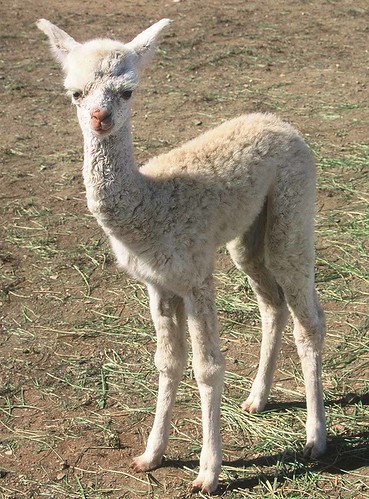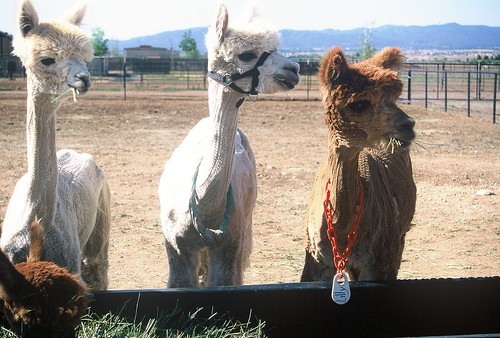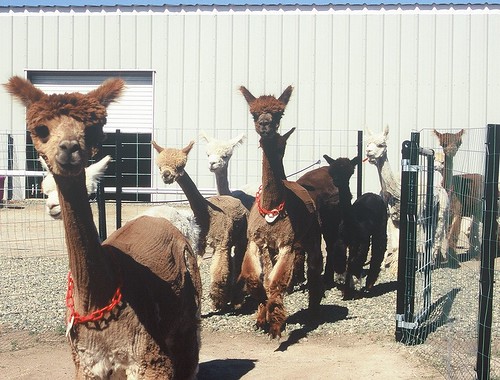Adventures with Alpacas
Posted in Travel | By Shelley Gillespie | Tags: Alpacas, Animals, Investments, US Domestic Travel
We were invited by the Decker sisters to visit their alpaca ranch, Tranquil Spirits. A cria, a baby alpaca, had recently been born and they were expecting more. Lady Godiva, or “Lady G,” as the Decker sisters called their first cria, was born early, weighing only 13 pounds, 1 ounce. For a human, that would be extraordinary, but Lady G was in jeopardy since she was only about half of a normal birth weight.

Lady G
Adult alpacas typically weigh 120-170 pounds, with their cria usually one-fifth of the adult weight at birth. After a head-first delivery that is not the norm for alpacas, Lady G had to be bottle fed by Janice and Karrie at two-hour intervals, since her mother was not capable of nursing her. Bonding and development, as with humans, was in jeopardy because of this lack of nursing. The gangly cria was not capable of eating hay, so the bottle was her only form of nourishment for several days.
About alpacas
While their relatives, llamas, tend to have bad manners and spit at you, alpacas are gentle and have a peaceful air about them.
The spindly-legged creatures have been around for thousands of years and are prized for their “fiber,” the ultra-soft fleece that is harvested.
Alpacas are herd animals who band together to protect themselves. Vulnerable to predators, alpaca males will make a screeching noise to alert the herd to a threat. Their vision and awareness extends far beyond that of humans.

Chow time!
Prized for their fiber or fleece, the fiber is sold through cooperatives, then used by spinners to make some of the softest sweaters, dresses, blankets and other knitted items available. Unlike wool, alpaca fiber is low in lanolin, so the fiber is light, airy, and comes in many colors, depending on the heritage of the animal. So valuable that it is sold by the ounce, alpaca fiber is measured in microns for softness. An ounce can sell for $2.00 to $5.00 per ounce of raw fiber.
Alpacas are grouped by the type of fiber they produce, either Suri or Haucaya. The Tranquil Spirits alpaca are all Huacaya, having shorter, denser, crimped fiber that is easier to spin. Suri alpaca have straight, long fleece.
Alpaca are shorn once a year before the warm weather sets in. Shearing professionals from New Zealand were brought in by the Deckers so that the alpaca would be shorn quickly and safely. Less experienced shearers take up to 45 minutes to remove the dense coat from an alpaca. The professionals can complete a shearing in five to eight minutes with no nicks or injuries to the alpaca.

It's time to eat!
Like cows, they chew their cud. Unlike cows that have two stomachs, alpacas have three stomachs. Chewing contemplatively, they amble about the field, occasionally trotting, usually in groups.
Clean animals, the alpacas create several sites where they leave their droppings, instead of fouling their entire enclosure. As a result of their simple diet and clean habits, alpaca are easy to maintain.
Why own alpacas?
Importation of alpacas into the US has been banned since 1998, but US alpaca ranchers have raised thousands of alpacas since then. Alpacas don’t demand much attention and ranchers are raising them for investment, both for new herds and to sell the fiber.
Aah…
My motherly instincts kicked in very quickly. The babies were awkward, skinny creatures who seem to be very peaceful. It is easy to understand why people would want to raise them. Their fiber is exquisite, they’re not difficult to care for and they are comfortable to be around.
No wonder the Decker sisters started an alpaca ranch!
More about Tranquil Spirits at http://www.tranquilspiritsalpacas.com. They welcome interested visitors to their ranch in California – with notice.
Tags: Alpacas, Animals, Investments, US Domestic Travel
